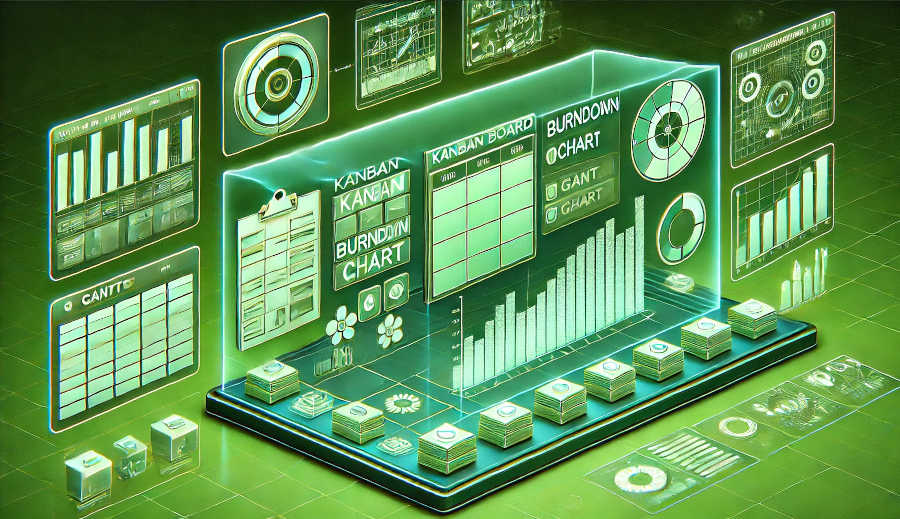Construction projects have a profound impact on the environment, economy, and society. In recent years, the concept of green construction and sustainable development has gained significant traction in the construction industry. Green concept in construction project management emphasizes minimizing the environmental footprint of construction activities while ensuring the long - term viability and functionality of the built environment. Sustainable development in this context aims to balance economic growth, social well - being, and environmental protection throughout the project lifecycle.
The construction industry is one of the major consumers of natural resources and a significant contributor to environmental pollution. Traditional construction methods often involve high energy consumption, large amounts of waste generation, and the use of non - renewable materials. By adopting green concepts and sustainable development principles, the industry can reduce its negative impacts and move towards a more circular and regenerative model. This not only benefits the environment but also creates opportunities for cost savings, improved project quality, and enhanced corporate social responsibility.
Moreover, with the increasing awareness of climate change and the need for environmental conservation among the public, clients, and regulatory bodies, construction companies that embrace green and sustainable practices are better positioned to gain a competitive edge in the market. They can attract environmentally conscious clients, meet regulatory requirements more easily, and contribute to the overall well - being of society.
Green Building Materials and Resources Management
One of the key aspects of green concept in construction project management is the selection and use of sustainable building materials. Green building materials are those that have a low environmental impact during their extraction, production, transportation, use, and disposal. For example, recycled materials such as recycled steel, glass, and plastic can be used in construction, reducing the need for virgin materials extraction. These recycled materials often require less energy to produce compared to their virgin counterparts.
In addition, locally sourced materials are preferred as they reduce the carbon footprint associated with transportation. By using materials that are produced nearby, the emissions from long - distance shipping can be minimized. Another important consideration is the use of renewable materials like bamboo, which is a fast - growing and sustainable alternative to traditional timber. Bamboo can be used for various construction elements such as flooring, wall panels, and structural components.
Effective resources management also extends to water conservation. Construction sites can implement water - saving measures such as rainwater harvesting systems. These systems collect rainwater for use in activities like dust suppression, concrete mixing, and landscape irrigation. Additionally, water - efficient fixtures and appliances can be installed in the buildings during construction, reducing the long - term water consumption of the finished structure. This not only helps in conserving a precious resource but also reduces the operational costs of the building.
Energy Efficiency in Construction and Operation
Energy efficiency is a crucial element of sustainable construction project management. During the construction phase, energy - efficient construction techniques can be employed. For instance, building insulation can be installed properly to reduce heat transfer, which in turn reduces the energy required for heating and cooling the building in the future. High - performance windows with low - emissivity coatings can also be used to minimize heat gain in summer and heat loss in winter.
In terms of construction equipment, the use of energy - efficient machinery can significantly reduce the energy consumption on the construction site. Electric or hybrid construction vehicles and tools are becoming more popular as they produce fewer emissions and consume less fuel compared to traditional diesel - powered equipment.
Once the building is completed, its energy performance during operation is of utmost importance. Incorporating renewable energy sources such as solar panels on the building's roof can generate electricity for the building's use. Geothermal energy systems can also be installed to provide heating and cooling, which are highly efficient and environmentally friendly. Energy management systems can be put in place to monitor and control the energy consumption of the building, allowing for optimization of energy use and reduction of waste.
Waste Reduction and Management

Waste generation is a significant issue in construction projects. Traditional construction methods often result in large amounts of waste, including construction debris, packaging materials, and surplus building materials. To address this, waste reduction strategies should be implemented from the planning stage of the project.
One approach is to use prefabrication techniques. Prefabricated building components are manufactured in a factory setting under controlled conditions, which can reduce waste as the production process is more precise. The off - site manufacturing also allows for better management of materials and reduces the amount of waste generated on the construction site.
During the construction process, waste segregation should be strictly enforced. Different types of waste, such as concrete, wood, metal, and plastic, should be separated so that they can be recycled or reused more effectively. For example, concrete waste can be crushed and used as aggregate for new concrete production, while wood waste can be used for fuel or processed into engineered wood products.
After the project is completed, proper waste disposal procedures should be followed. Construction companies should work with licensed waste management contractors to ensure that waste is disposed of in an environmentally responsible manner. This may involve sending recyclable materials to recycling facilities and ensuring that hazardous waste is treated and disposed of safely.
Social and Community Considerations
Sustainable construction project management also takes into account social and community aspects. A construction project should have a positive impact on the local community. This can be achieved through various means, such as providing employment opportunities for local residents during the construction phase. By hiring locally, the project can contribute to the economic development of the area and improve the livelihoods of the local people.
In addition, the design of the building should consider the needs of the community. For example, public buildings such as schools and hospitals should be designed to be accessible to all members of the community, including those with disabilities. The location of the building should also be carefully considered to minimize disruption to the existing community infrastructure and lifestyle.
Furthermore, construction projects can contribute to the cultural heritage of the area. If the project site has historical or cultural significance, appropriate measures should be taken to preserve and protect these elements. This could involve incorporating historical features into the new design or conducting archaeological surveys before construction begins.
Conclusion
In conclusion, the adoption of green concepts and sustainable development principles in construction project management is not only a necessity but also a strategic advantage for the construction industry. By focusing on green building materials and resources management, energy efficiency in construction and operation, waste reduction and management, as well as social and community considerations, construction projects can have a significantly reduced environmental impact while still meeting the needs of the clients and the society.
The use of sustainable building materials and effective resources management helps in conserving natural resources and reducing pollution. Energy - efficient construction and operation not only cut down on energy costs but also contribute to the global effort to combat climate change. Waste reduction and proper management minimize the amount of waste going to landfills and promote a circular economy. And considering social and community aspects ensures that construction projects are in harmony with the local environment and people.
As the world continues to face environmental challenges and the demand for sustainable development grows, the construction industry must continue to innovate and improve its practices. Construction companies that lead the way in implementing green and sustainable strategies will not only be better positioned to meet future regulatory requirements but also gain a competitive edge in the market. They will be able to attract more clients, build a positive reputation, and contribute to a more sustainable future for all. It is essential that all stakeholders in the construction industry, including contractors, designers, clients, and regulatory bodies, work together to promote and implement these green and sustainable practices in construction project management.
ARTICLE TITLE :Green concept and sustainable development of construction project management ,AUTHOR :ITpmlib

















